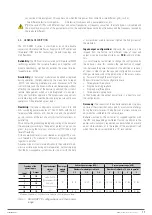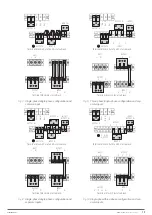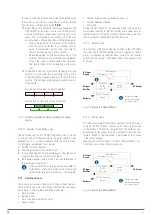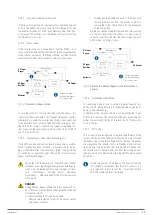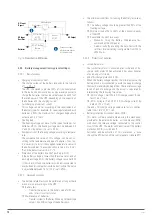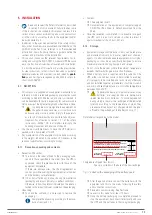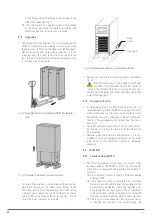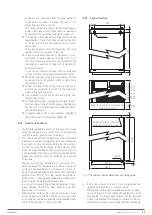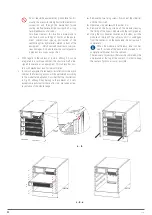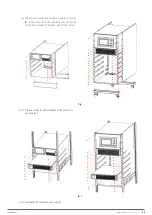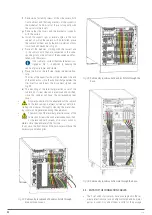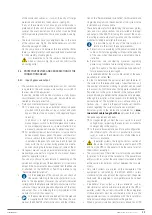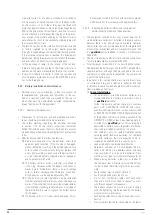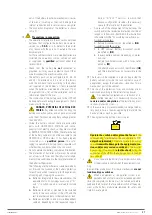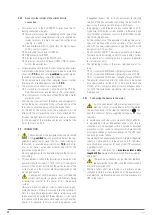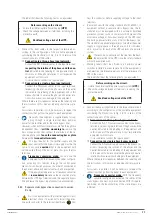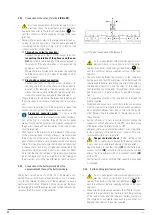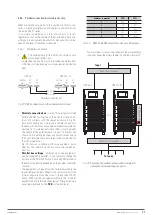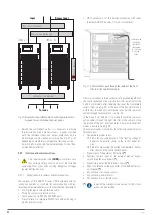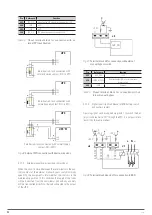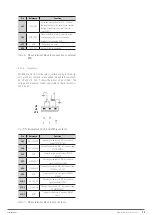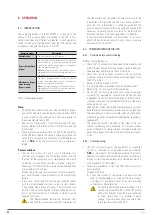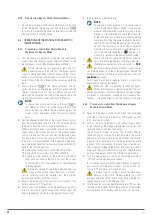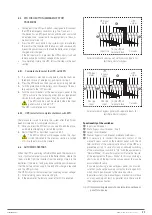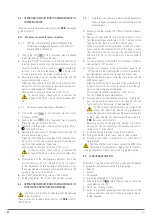
25
of the connection cables, as it avoids the entry of foreign
materials and vermin into the enclosure -see Fig. 24-.
If any of these means is not enough or another mode is
preferred, at the base of the subrack there is a mechanized
cover at the user's discretion and in which it can be fitted
with larger cable glands than those ones provided -see Fig.
25-.
•
The 6-slot subracks have two elliptical holes in the base
of the subrack -see Fig 26-. Make the necessary cuts that
allow the passage of cables.
On the same base and between the two elliptical holes
there is a metal plate that can be extracted and mechanized
for the assembly of cable glands.
It is imperative to fix the cables to the points pro-
vided as shown in Fig. 26, so as do not obstruct the
air cooling outlet.
5.4. PROTECTIVE DEVICES AND CROSS SECTION OF THE
CONNECTION CABLES.
5.4.1. Input, bypass and output.
•
The subracks do not incorporate protections, nor switches
to operate by the user, except a manual bypass switch in
the rear side of the equipment.
In addition, models with 2 and 4 slots have a static bypass
circuit breaker switch on the rear side, but should be con-
sidered as internal protection.
•
Protection or external manual bypass panel:
It is necessary to have an external protection panel
provided with the switches of input, output, and static
bypass (the last one on models with separate bypass
line only).
In addition it is highly recommended to include a
manual bypass switch to facilitate preventive mainte-
nance or repairing operations, so we will refer to it as
a manual bypass panel instead of a protection panel.
For parallel systems of 6-slot subracks, it is essential to
have a manual bypass panel. The panel switches must
allow a subrack to be isolated from the set of systems
in parallel in the event of any anomaly and to feed the
loads with the rest, either during preventive mainte-
nance or during the failure and repair of some of them.
•
On request we can supply an external protection panel or
manual bypass panel for a single unit or a manual bypass
panel for a parallel system.
You can also choose to manufacture it, depending on the
version and configuration of the equipment or system avail-
able and the documentation downloaded from the Website
or attached on the CD-ROM or Pen Drive related to the
"Recommended installation".
•
On the nameplate of the subrack you can check all
the values referring to the main characteristics re-
lated to the equipment. However, the currents indicated
correspond to the higher power model manufactured in that
subrack at the same voltage and configuration of the input
and output. That is, considering that it incorporates all the
modules for which it has capacity.
•
In the documentation downloaded from the website
or supplied with the CD-ROM or Pen Drive, the user
manual, the EK266*08 safety instructions and the informa-
tion on the "Recommended installation", technical data and
single-line diagrams on the connection of the system to the
installation, are also available.
These data are useful for determining the minimum protec-
tions and cross cable sections to be installed at the input
and output of the ADAPT X, taking into account their nom-
inal voltage, input-output configuration and the number of
modules installed in parallel in the subrack.
It is possible to opt for any of the two solutions in
relation to the size of the panel protections:
a.
Protections size according to the power installed in the
subrack. For future upgrading will require the updating
of the sizes when the protection is adjusted to the in-
stallation.
b.
Protections size considering maximum upgrading
power or up to where future scaling extension is envis-
aged. This option is the most economically beneficial if
future expansions are envisaged.
It is recommended that the cross cable section of the panel
be suitable for option “
b.
”.
•
In order to determine the particular technical features of
the system in the respective table of specifications, only
the number of modules working in parallel will be taken
into account, but not those ones that operate in redundant.
Pay attention to the notes indicated in the tables and that
are conditioning to determine the respective data provided,
although the installer will be responsible for defining the
particularities of the installation (cross cble sections, pro-
tections size, ...), since it is the person who has all the infor-
mation regarding the system's location environment.
All values given in the tables are calculated for a
max-
imum total cable length of 30 m
between the distribu-
tion panel, equipment and loads.
For longer lengths correct the cross sections to avoid
voltage drops, respecting the regulations or standards
corresponding to the country.
In the same documentation and for each configuration,
the information for «N» units in parallel (in 6-slot sub-
rack), as well as the characteristics of «Backfeed pro-
tection» is available.
•
In parallel systems, the length and cross section of
the cables from the protection panel to each UPS
and from the UPS to the panel will be the same for all of
them without exception.
•
The cross section of the cables must always be considered
in relation to the size of the terminals of the power block
and/or switches, so that they are correctly fastened in their
entire section for optimum contact between the two ele-
ments.
•
Only rated currents are printed on the nameplate of the
equipment as indicated by the EN-IEC 62040-1 safety
standard. For the calculation of the input current, the power
factor and the equipment's own performance have been
considered.
•
If peripheral input, output or bypass elements such as
transformers or autotransformers are added to the UPS or
parallel system, the currents indicated on the nameplates
of these elements must be considered in order to use the
appropriate sections, in compliance with the local and/or
national Low Voltage Electrotechnical Regulation.
•
When a galvanic isolation transformer is added to an UPS
EMi3
SERVOMOTOR VOLTAGE STABILISER
USER'S MANUAL

